Estimation of Shortwave Solar Radiation on Clear-Sky Days for a Valley Glacier with Sentinel-2 Time Series
Abstract
1. Introduction
2. Study Area and Data
2.1. Study Area
2.2. Data Sources
3. Methods
3.1. Shortwave Solar Radiation in Mountainous Areas
3.2. Inversion of the Input Parameters
3.2.1. Retrieval of AOD and PW Products
3.2.2. Retrieval of Ice/Snow Albedo in Mountainous Terrain
4. Results
4.1. Evaluation against Ground-Based Measurements
4.2. Mapping Solar Radiation
4.3. Spatial Profile Characteristics
4.4. Spatiotemporal Variation
5. Discussion
5.1. Impact of the DEM Spatial Scale on Topographic Normalization
5.2. Terrain Impacts on the DSSR Received by Ice/Snow Surfaces
5.3. Reliability of the Inversion of Atmospheric Transmittance Using S2 Data
5.4. Limitations of the DSSR Estimation Method
6. Conclusions
Author Contributions
Funding
Acknowledgments
Conflicts of Interest
Abbreviations
| DSSR | downward surface shortwave radiation (W m−2) |
| MODIS | Moderate Resolution Imaging Spectroradiometer |
| TM | Landsat Thematic Mapper |
| ESA | European Space Agency |
| S2 A/B | Sentinel-2A and Sentinel-2B |
| MSI | Multispectral Imager |
| DLR | German Aerospace Center |
| WMO | World Meteorological Organization |
| UTM/WGS84 | Universal Transverse Mercator/World Geodetic System |
| AWS | automatic weather station |
| S2 | Sentinel-2 |
| VNIR | visible and near-infrared |
| SWIR | shortwave infrared |
| AOD | aerosol optical depth |
| PW | precipitable water (cm) |
| TOA | top of the atmosphere |
| BOA | bottom of atmosphere |
| BRDF | bidirectional reflectance distribution function |
| GIPP | ground image processing parameter |
| DDV | dense dark vegetation |
| APDA | atmospheric pre-corrected differential absorption |
| MBE | mean bias error |
| MBE% | MBE percentage |
| RMSD | root-mean-square difference |
| RMSD % | RMSD percentage |
| surface global irradiance (W m−2) | |
| direct irradiance (W m−2) | |
| diffuse irradiance (W m−2) | |
| isotropic diffuse irradiance (W m−2) | |
| anisotropic diffuse irradiance (W m−2) | |
| surrounding-reflected irradiance (W m−2) | |
| cosine of solar illumination angle on a sloped grid | |
| obstruction coefficient | |
| sky view factor | |
| topographic configuration factor |
References
- Irving, A. Solar radiation and glacier motion. Nature 1883, 27, 553–554. [Google Scholar] [CrossRef]
- Kruss, P.D.; Hastenrath, S. The role of radiation geometry in the climate response of Mount Kenya’s glaciers, part I: Horizontal reference surfaces. Int. J. Climatol. 1987, 7, 493–505. [Google Scholar] [CrossRef]
- Mölg, T.; Cullen, N.J.; Hardy, D.R.; Kaser, G.; Klok, L. Mass balance of a slope glacier on kilimanjaro and its sensitivity to climate. Int. J. Climatol. 2008, 28, 881–892. [Google Scholar]
- Vastag, B. The melting snows of Kilimanjaro. Nat. Med. 2009, 291, 1690–1691. [Google Scholar] [CrossRef]
- Zhang, G.; Kang, S.; Cuo, L.; Qu, B. Modeling hydrological process in a glacier basin on the central Tibetan Plateau with a Distributed Hydrology Soil Vegetation Model. J. Geophys. Res. Atmos. 2016, 121, 9521–9539. [Google Scholar] [CrossRef]
- Chen, J.; Qin, X.; Kang, S.; Du, W.; Sun, W.; Liu, Y. Effects of clouds on surface melting of Laohugou glacier No. 12, western Qilian Mountains, China. J. Glaciol. 2018, 64, 89–99. [Google Scholar] [CrossRef]
- Oerlemans, J.; Knap, W.H. A 1 year record of global radiation and albedo in the ablation zone of Morteratschgletscher, Switzerland. J. Glaciol. 1998, 44, 231–238. [Google Scholar] [CrossRef]
- Mölg, T.; Georges, C.; Kaser, G. The contribution of increased incoming shortwave radiation to the retreat of the Rwenzori Glaciers, East Africa, during the 20th century. Int. J. Climatol. 2003, 23, 291–303. [Google Scholar] [CrossRef]
- Huss, M.; Funk, M.; Ohmura, A. Strong Alpine glacier melt in the 1940s due to enhanced solar radiation. Geophys. Res. Lett. 2009, 36, L23501. [Google Scholar] [CrossRef]
- Zhu, M.; Yao, T.; Yang, W.; Maussion, F.; Huintjes, E.; Li, S. Energy- and mass-balance comparison between Zhadang and Parlung No. 4 glaciers on the Tibetan Plateau. J. Glaciol. 2015, 61, 595–607. [Google Scholar] [CrossRef]
- Gerd, W.; Nobuyoshi, I. The effect of slope, exposure and mountain screening on the solar radiation of mccall glacier, alaska: A contribution to the international hydrological decade. J. Glaciol. 1974, 13, 213–226. [Google Scholar]
- Arnold, N.S.; Willis, I.C.; Sharp, M.J.; Richards, K.S.; Lawson, W.J. A distributed surface energy-balance model for a small valley glacier. I. Development and testing for haut glacier d’Arolla, Valais, Switzerland. J. Glaciol. 1996, 42, 77–89. [Google Scholar] [CrossRef][Green Version]
- Arnold, N.S.; Rees, W.G.; Hodson, A.J.; Kohler, J. Topographic controls on the surface energy balance of a high arctic valley glacier. J. Geophys. Res. Earth Surf. 2006, 111. [Google Scholar] [CrossRef]
- Dumont, M.; Gardelle, J.; Sirguey, P.; Guillot, A.; Six, D.; Rabatel, A.; Arnaud, Y. Linking glacier annual mass balance and glacier albedo retrieved from modis data. Cryosphere 2012, 6, 1527–1539. [Google Scholar] [CrossRef]
- Davaze, L.; Rabatel, A.; Arnaud, Y.; Sirguey, P.; Six, D.; Letreguilly, A.; Dumont, M. Monitoring glacier albedo as a proxy to derive summer and annual surface mass balances from optical remote-sensing data. Cryosphere 2018, 12, 271–286. [Google Scholar] [CrossRef]
- Yang, K.; Koike, T.; Ye, B. Improving estimation of hourly, daily, and monthly solar radiation by importing global data sets. Agric. For. Meteorol. 2006, 137, 43–55. [Google Scholar] [CrossRef]
- Munro, D.S.; Young, G.J. An operational net shortwave radiation model for glacier basins. Water Resour. Res. 1982, 18, 220–230. [Google Scholar] [CrossRef]
- Naegeli, K.; Damm, A.; Huss, M.; Wulf, H.; Schaepman, M.; Hoelzle, M. Cross-Comparison of Albedo Products for Glacier Surfaces Derived from Airborne and Satellite (Sentinel-2 and Landsat 8) Optical Data. Remote Sens. 2017, 9, 110. [Google Scholar] [CrossRef]
- Hastenrath, S.; Patnaik, J.K. Radiation measurement at Lewis Glacier, Mount Kenya, Kenya. J. Glaciol. 1980, 25, 439–444. [Google Scholar] [CrossRef][Green Version]
- Dozier, J. A clear-sky spectral solar radiation model for snow-covered mountainous terrain. Water Resour. Res. 1980, 16, 709–718. [Google Scholar] [CrossRef]
- Dozier, J.; Frew, J. Rapid calculation of terrain parameters for radiation modeling from digital elevation data. Geosci. Remote Sens. IEEE Trans. 1990, 28, 963–969. [Google Scholar] [CrossRef]
- Li, X.; Cheng, G.; Chen, X.; Lu, L. Modification of solar radiation model over rugged terrain. Chin. Sci. Bull. 1999, 44, 1345–1349. [Google Scholar] [CrossRef]
- Li, X.; Koike, T.; Cheng, G.D. Retrieval of snow reflectance from Landsat data in rugged terrain. Ann. Glaciol. 2002, 34, 31–37. [Google Scholar]
- Hastenrath, S.; Kruss, P.D. The role of radiation geometry in the climate response of Mount Kenya’s glaciers, part 2: Sloping versus horizontal surfaces. Int. J. Climatol. 1988, 8, 629–639. [Google Scholar] [CrossRef]
- Kruss, P.D.; Hastenrath, S. The role of radiation geometry in the climate response of Mount Kenya’s glaciers, part 3: The latitude effect. Int. J. Climatol. 1990, 10, 321–328. [Google Scholar] [CrossRef]
- Klok, E.J.; Oerlemans, J. Model study of the spatial distribution of the energy and mass balance of Morteratschgletscher, Switzerland. J. Glaciol. 2002, 48, 505–518. [Google Scholar] [CrossRef]
- Jiskoot, H.; Mueller, M.S. Glacier fragmentation effects on surface energy balance and runoff: Field measurements and distributed modelling. Hydrol. Process. 2012, 26, 1861–1875. [Google Scholar] [CrossRef]
- Kääb, A.; Treichler, D.; Nuth, C.; Berthier, E. Brief communication: Contending estimates of 2003–2008 glacier mass balance over the pamir–karakoram–himalaya. Cryosphere 2015, 9, 557–564. [Google Scholar] [CrossRef]
- Kääb, A.; Winsvold, S.H.; Altena, B.; Nuth, C.; Nagler, T.; Wuite, J. Glacier remote sensing using Sentinel-2. Part I: Radiometric and geometric performance, and application to ice velocity. Remote Sens. 2016, 8, 598. [Google Scholar] [CrossRef]
- Zhang, Y.; Li, X.; Bai, Y. An integrated approach to estimate shortwave solar radiation on clear-sky days in rugged terrain using MODIS atmospheric products. Sol. Energy 2015, 113, 347–357. [Google Scholar] [CrossRef]
- Dozier, J. Spectral signature of alpine snow cover from the landsat thematic mapper. Remote Sens. Environ. 1989, 28, 9–22. [Google Scholar] [CrossRef]
- Fugazza, D.; Senese, A.; Azzoni, R.S.; Maugeri, M.; Diolaiuti, G.A. Spatial distribution of surface albedo at the Forni Glacier (Stelvio National Park, Central Italian Alps). Cold Reg. Sci. Technol. 2016, 125, 128–137. [Google Scholar] [CrossRef]
- Paul, F.; Winsvold, S.H.; Kääb, A.; Nagler, T.; Schwaizer, G. Glacier remote sensing using sentinel-2. Part II: Mapping glacier extents and surface facies, and comparison to Landsat 8. Remote Sens. 2016, 8, 575. [Google Scholar] [CrossRef]
- Sola, I.; García-Martín, A.; Sandonís-Pozo, L.; Álvarez-Mozos, J.; Pérez-Cabello, F.; González-Audícana, M.; Llovería, R.M. Assessment of atmospheric correction methods for Sentinel-2 images in Mediterranean landscapes. Int. J. Appl. Earth Obs. Geoinf. 2018, 73, 63–76. [Google Scholar] [CrossRef]
- Qin, X.; Cui, X.; Du, W.; Dong, Z.; Ren, J.; Chen, J. Variations of the alpine precipitation from an ice core record of the Laohugou glacier basin during 1960–2006 in western Qilian Mountains, China. J. Geogr. Sci. 2015, 25, 165–176. [Google Scholar] [CrossRef]
- Du, W.; Qin, X.; Liu, Y.; Wang, X. Variation of the Laohugou Glacier No. 12 in the Qilian Mountains during 1958–2005. J. Glaciol. Geocryol. 2008, 30, 373–379. [Google Scholar]
- Sun, W.; Qin, X.; Du, W.; Liu, W.; Liu, Y.; Zhang, T.; Ren, J. Ablation modeling and surface energy budget in the ablation zone of Laohugou glacier No. 12, western Qilian mountains, China. Ann. Glaciol. 2014, 55, 111–120. [Google Scholar] [CrossRef]
- Vuolo, F.; Żółtak, M.; Pipitone, C.; Zappa, L.; Wenng, H.; Immitzer, M.; Atzberger, C. Data service platform for Sentinel-2 surface reflectance and value-added products: System use and examples. Remote Sens. 2016, 8, 938. [Google Scholar] [CrossRef]
- Kaufman, Y.J.; Tanré, D.; Remer, L.A.; Vermote, E.F.; Chu, A.; Holben, B.N. Operational remote sensing of tropospheric aerosol over land from EOS moderate resolution imaging spectroradiometer. J. Geophysical Res. Atmos. 1997, 102, 17051–17067. [Google Scholar] [CrossRef]
- Schläpfer, D.; Borel, C.C.; Keller, J.; Itten, K.I. Atmospheric Precorrected Differential Absorption Technique to Retrieve Columnar Water Vapor. Remote Sens. Environ. 1998, 65, 353–366. [Google Scholar] [CrossRef]
- Müller-Wilm, U.; Louis, J.; Richter, R.; Gascon, F.; Niezette, M. Sentinel-2 Level-2A Prototype Processor: Architecture, Algorithms and First Results. In Proceedings of the ESA Living Planet Symposium, Edinburgh, UK, 9–13 September 2013; pp. 9–13. [Google Scholar]
- Zhang, Y.; Li, X.; Wen, J.; Liu, Q.; Yan, G. Improved topographic normalization for Landsat TM images by introducing the MODIS surface BRDF. Remote Sens. 2015, 7, 6558–6575. [Google Scholar] [CrossRef]
- Richter, R. Correction of satellite imagery over mountainous terrain. Appl. Opt. 1998, 37, 4004–4015. [Google Scholar] [CrossRef]
- Zhang, Y.; Yan, G.; Bai, Y. Sensitivity of Topographic Correction to the DEM Spatial Scale. IEEE Geosci. Remote Sens. Lett. 2015, 12, 53–57. [Google Scholar] [CrossRef]
- Arnold, N.; Rees, G. Effects of digital elevation model spatial resolution on distributed calculations of solar radiation loading on a High Arctic glacier. J. Glaciol. 2009, 55, 973–984. [Google Scholar] [CrossRef]
- Knap, W.H.; Reijmer, C.H.; Oerlemans, J. Narrowband to broadband conversion of Landsat TM glacier albedos. Int. J. Remote Sens. 1999, 20, 2091–2110. [Google Scholar] [CrossRef]
- Huang, G.; Liu, S.; Liang, S. Estimation of net surface shortwave radiation from MODIS data. Int. J. Remote Sens. 2012, 33, 804–825. [Google Scholar] [CrossRef]
- Jonsell, U.; Hock, R.; Holmgren, B. Spatial and temporal variations in albedo on Storglaciären, Sweden. J. Glaciol. 2003, 49, 59–68. [Google Scholar] [CrossRef]
- Hock, R.; Holmgren, B. A distributed surface energy-balance model for complex topography and its application to Storglaciaren, Sweden. J. Glaciol. 2005, 51, 25–36. [Google Scholar] [CrossRef]
- Greuell, W.; Reijmer, C.H.; Oerlemans, J. Narrowband-to-broadband albedo conversion for glacier ice and snow based on aircraft and near-surface measurements. Remote Sens. Environ. 2002, 82, 48–63. [Google Scholar] [CrossRef]
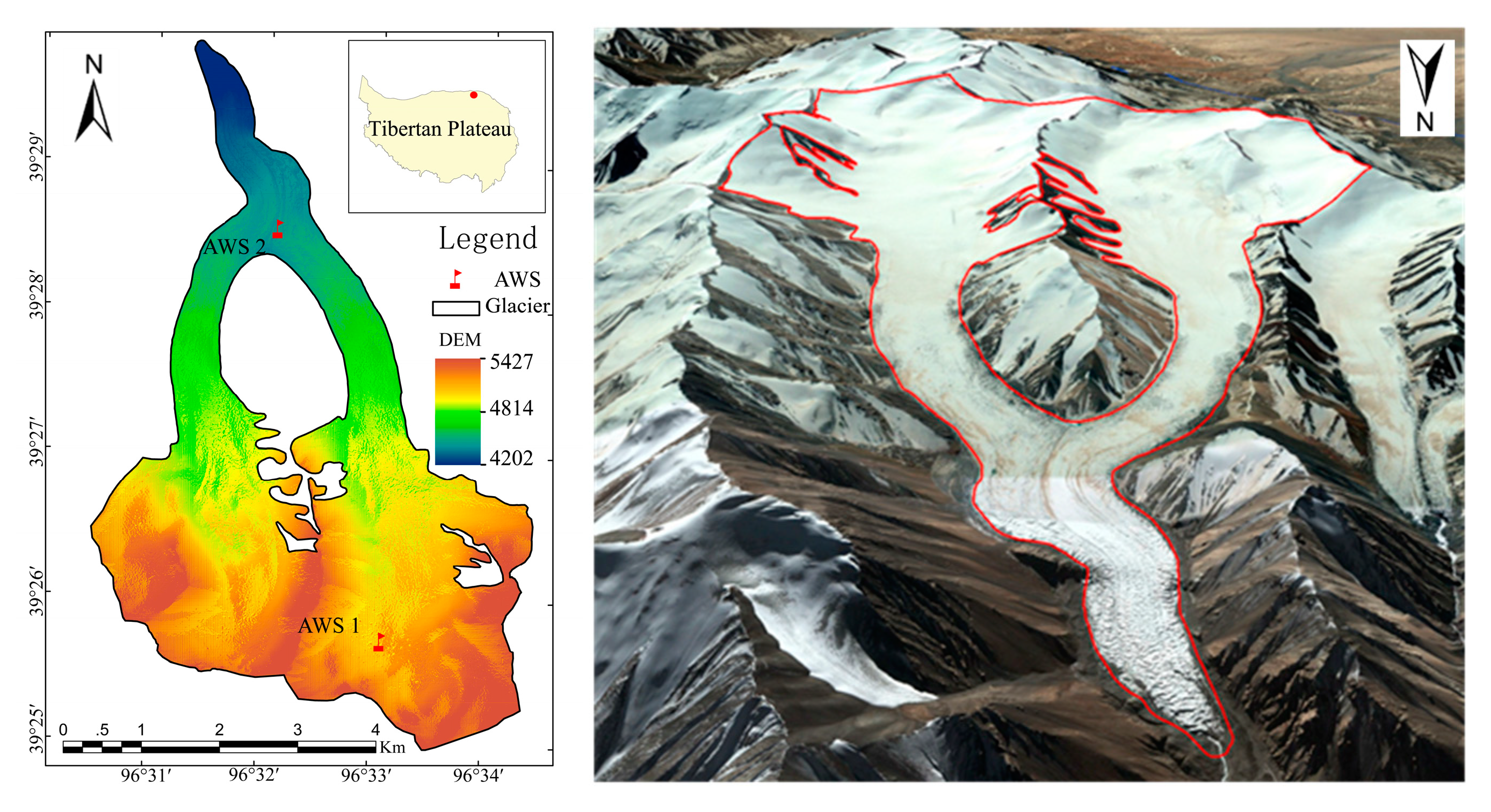

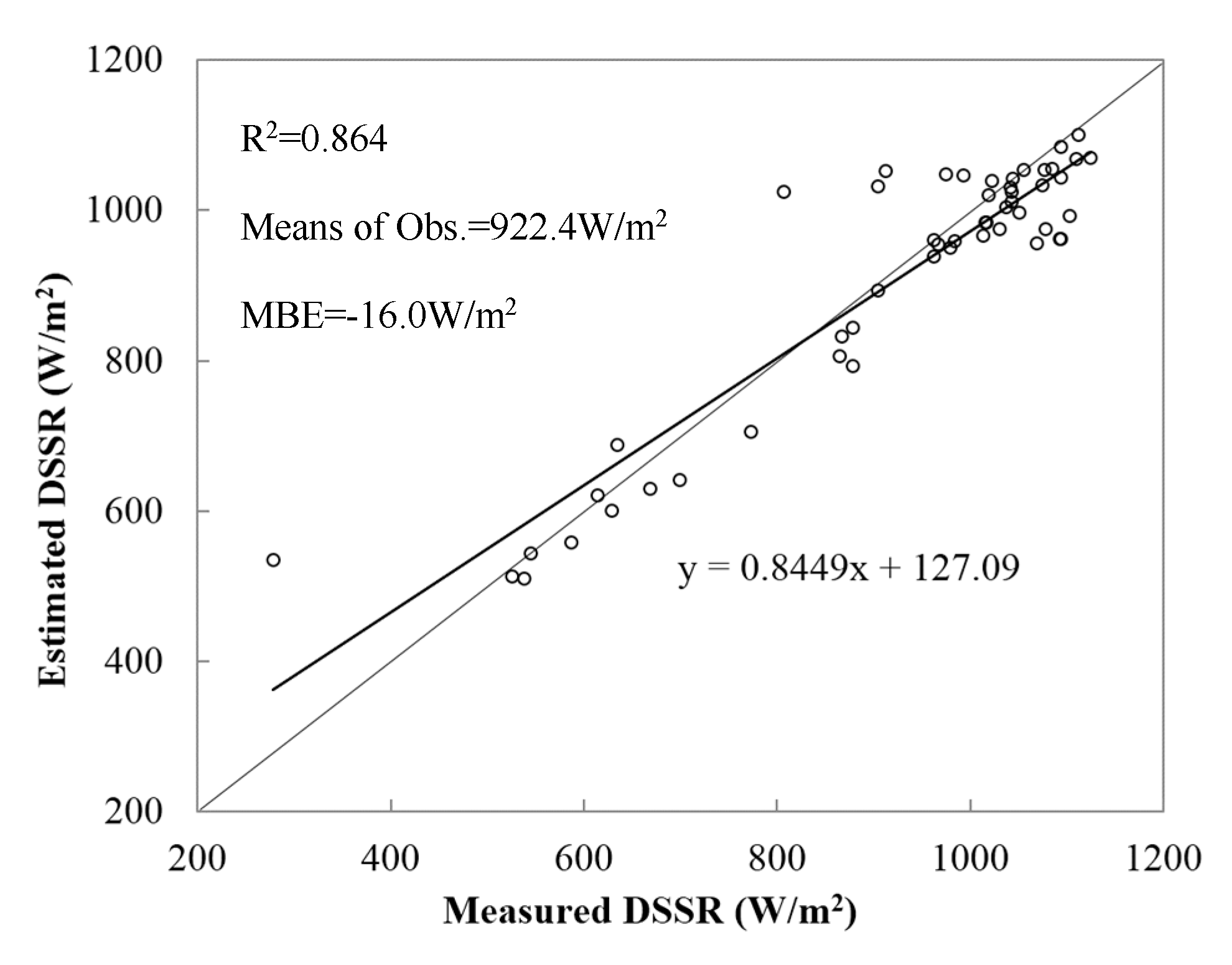
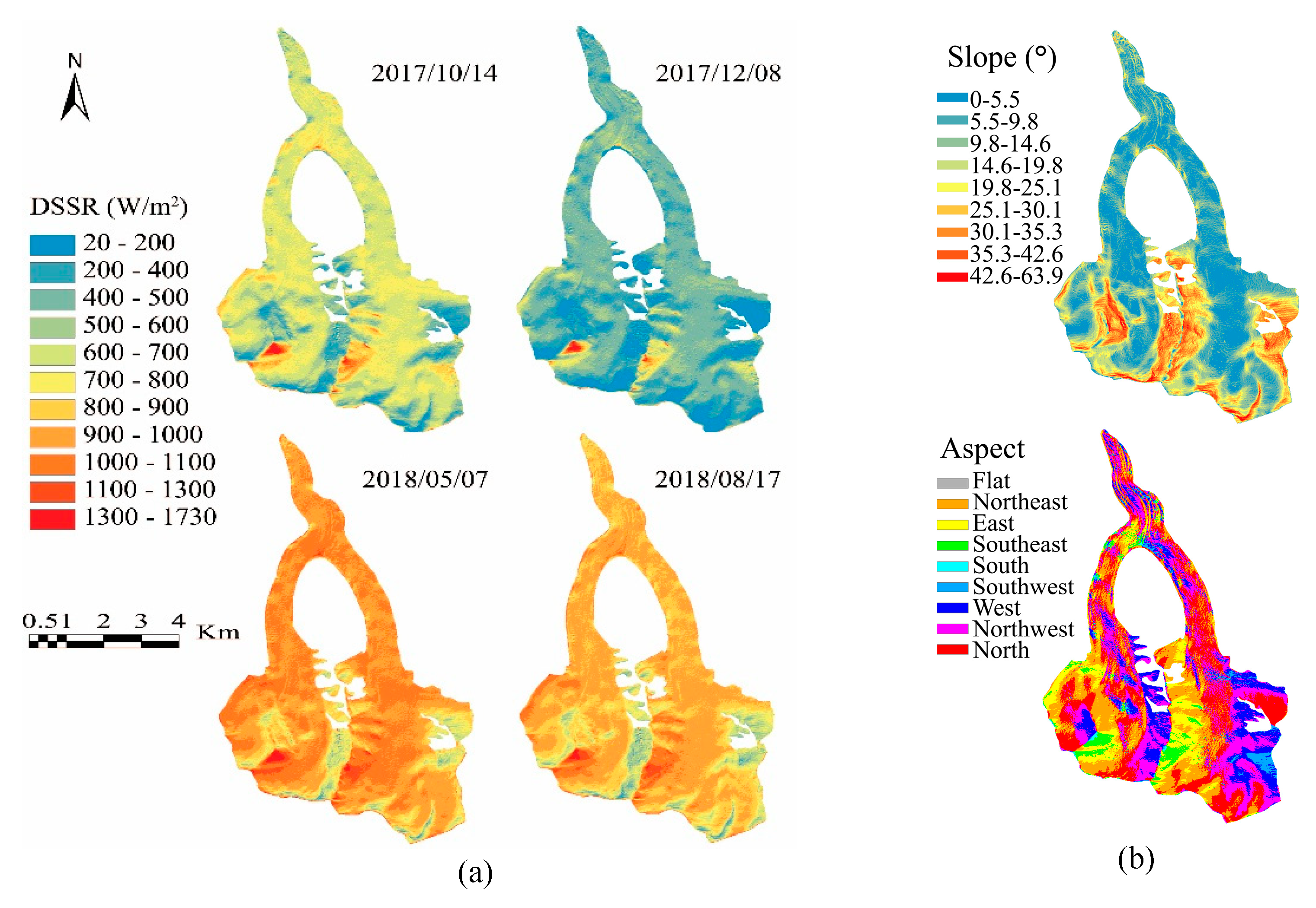

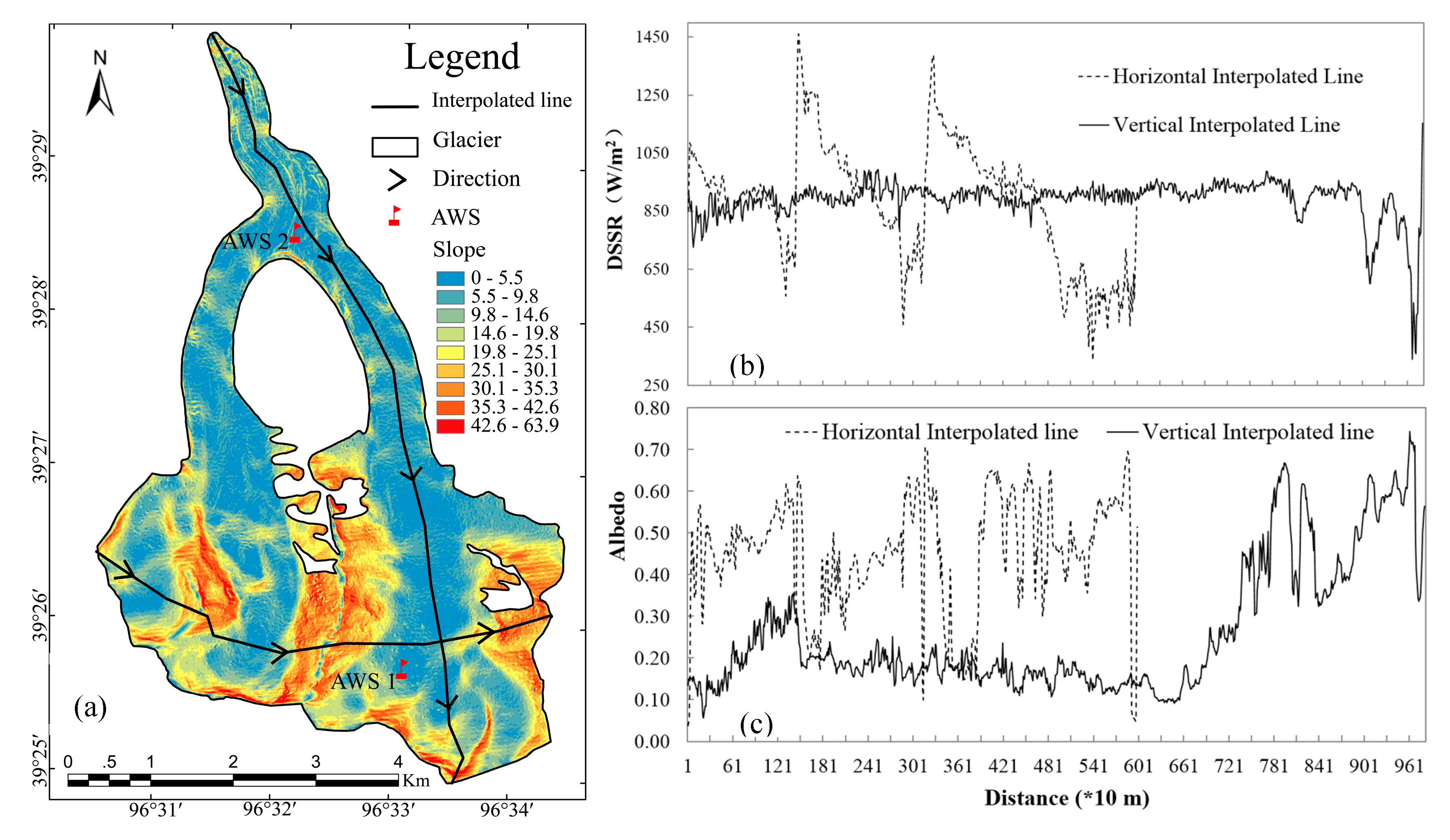
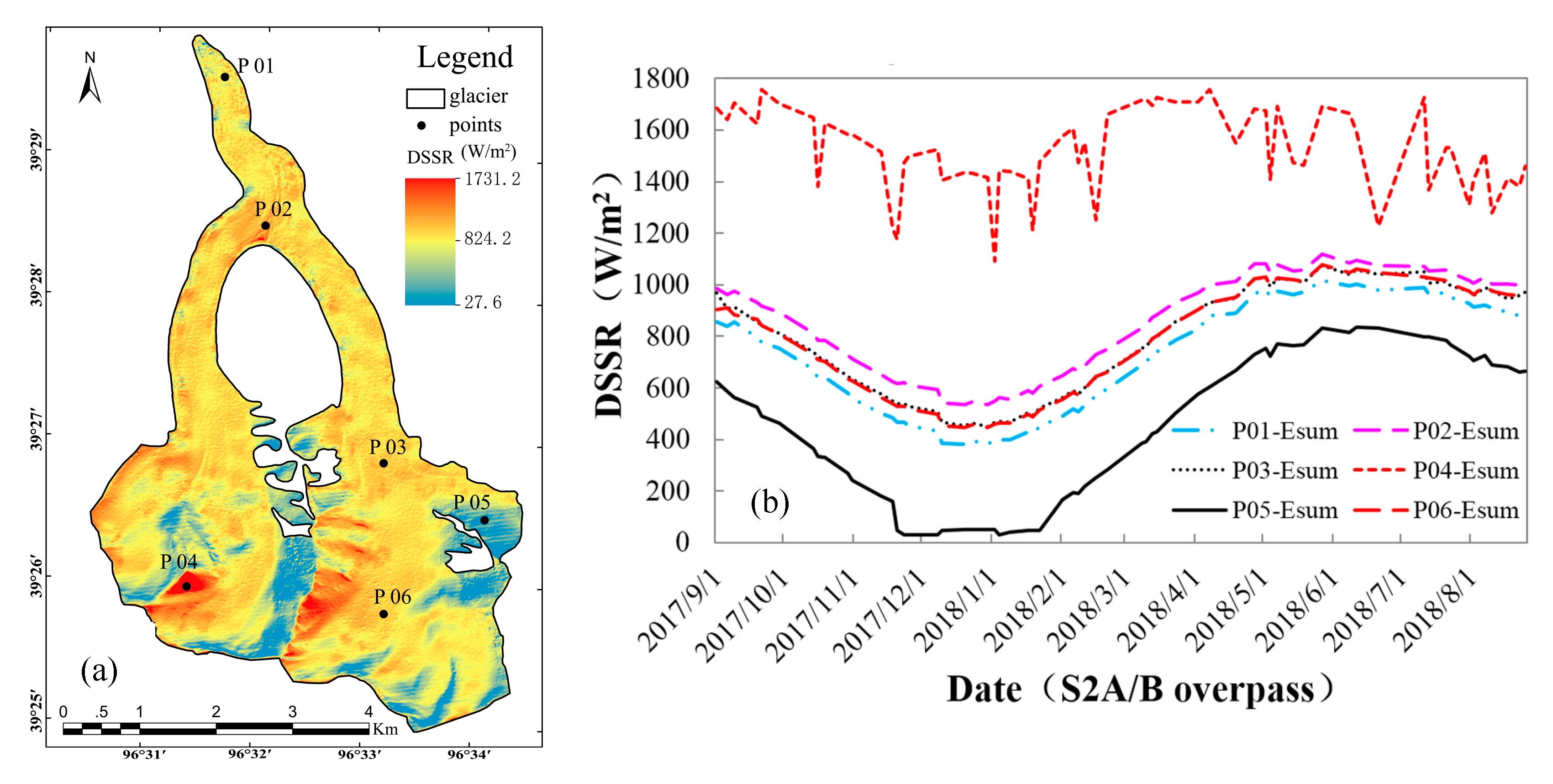
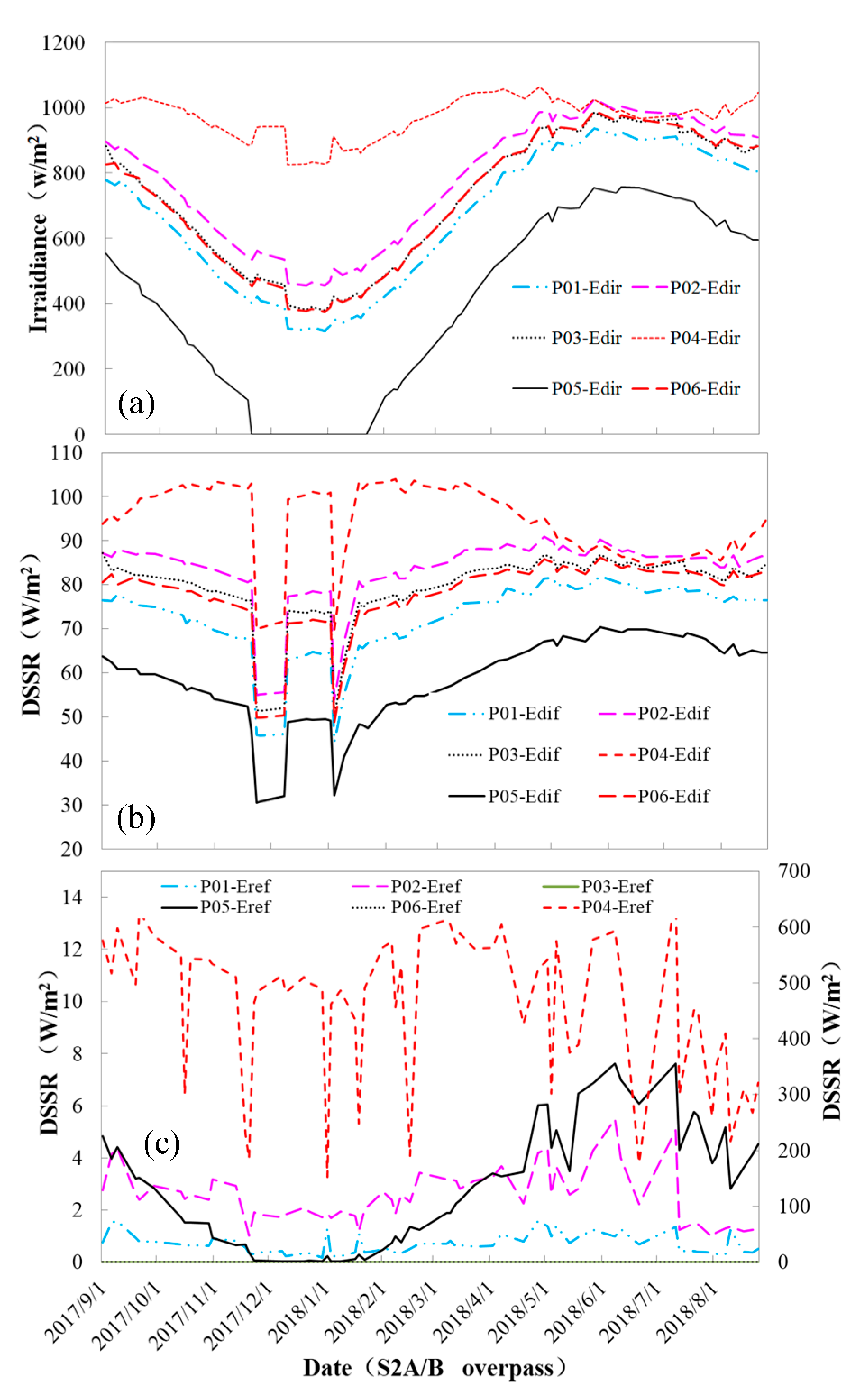
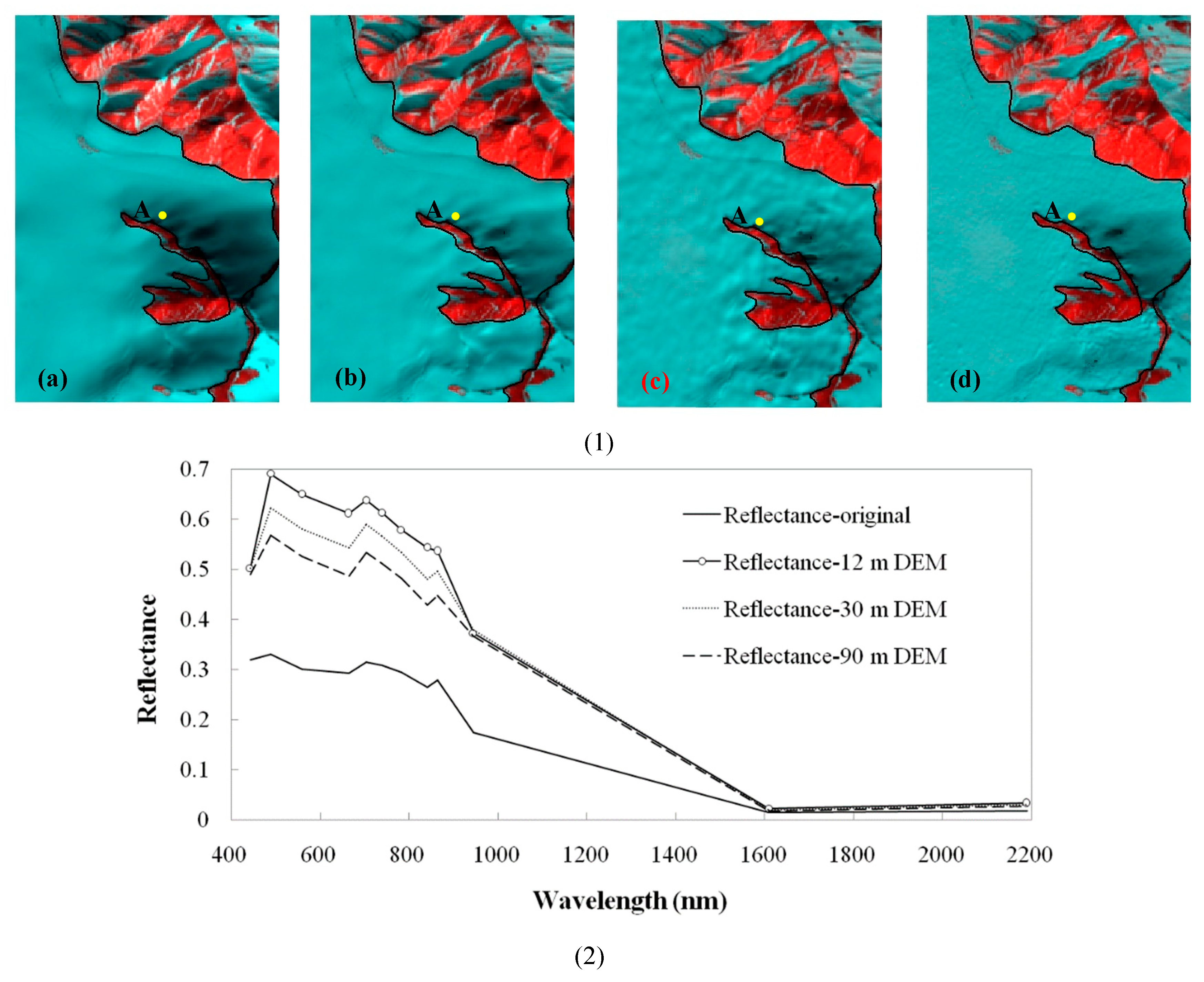
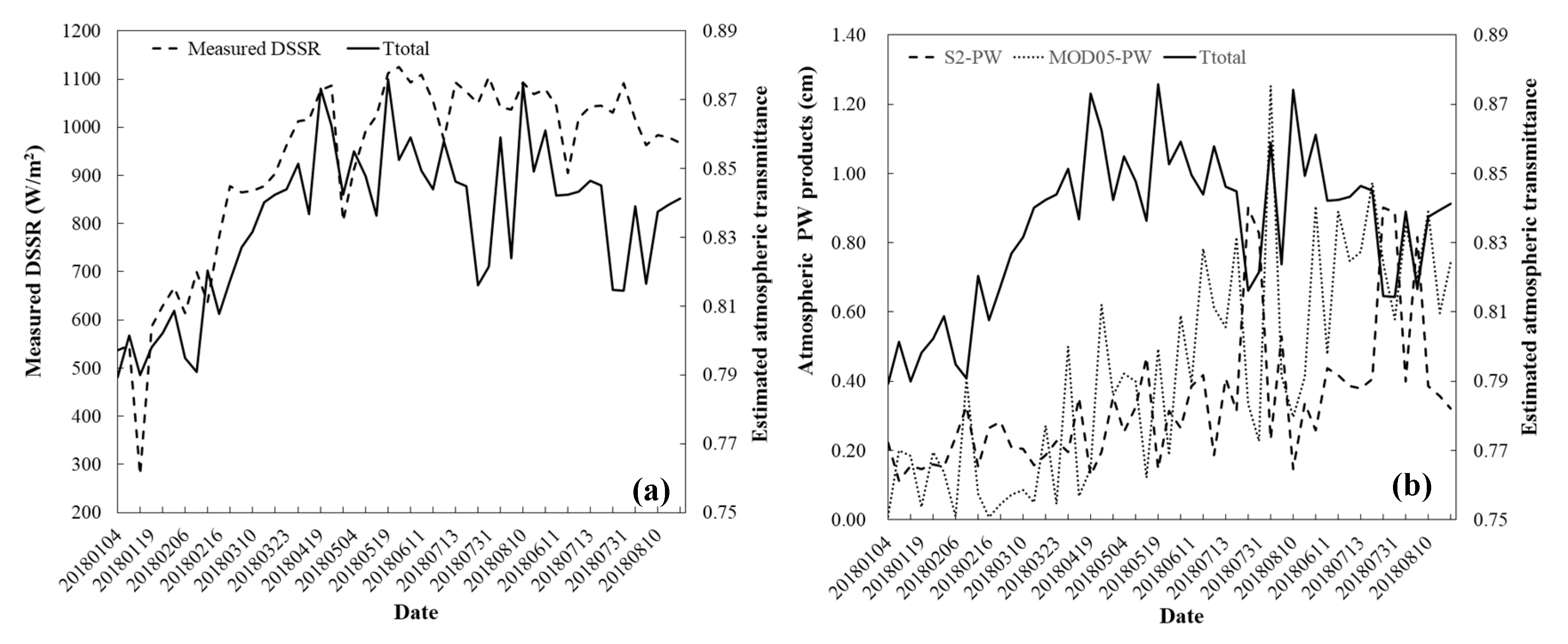
| Dataset | Data Source | Spatial Resolution | Main Test Period | Amount of Data | Applications |
|---|---|---|---|---|---|
| Sentinel-2A | ESA | 10 m | 2017/09/01–2018/08/25 | 27 scenes | PW/AOD/Albedo |
| Sentinel-2B | ESA | 10 m | 2017/09/01–2018/08/25 | 35 scenes | |
| DEM | DLR | 12 m | 2010–2015 | 1 scene | Terrain factors/Topographic correction |
| Pyranometer | AWS1 | 2018/01/04–2018/08/10 | 37 days | Precision verification | |
| AWS2 | 2018/05/27–2018/08/25 | 15 days |
| Parameters | Aerosol Type | PW | PW Threshold Cirrus | Cirrus | BRDF | BRDF Lower Bound | DEM | Smooth PW Map |
|---|---|---|---|---|---|---|---|---|
| Value | Rural | 940 nm | 0.55 | True | b = 1/2 | 0.22 | 12 m DEM | 100 m |
| Scene Date | S2 Satellite | Solar Zenith Angle (°) | DSSR Characteristics (W/m2) | |||
|---|---|---|---|---|---|---|
| Minimum | Maximum | Mean | Standard Deviation | |||
| 2017/10/14 | S2B | 48.7 | 33.6 | 1690.2 | 636.9 | 156.4 |
| 2017/12/08 | S2A | 63.2 | 22.9 | 1661.3 | 398.2 | 173.5 |
| 2018/05/07 | S2A | 25.4 | 24.7 | 1727.7 | 948.9 | 121.0 |
| 2018/08/17 | S2B | 30.3 | 26.7 | 1460.5 | 876.7 | 125.0 |
| Aspect (°) | Area (%) | Mean | Min | Max | Max-Min | Standard Deviation |
|---|---|---|---|---|---|---|
| North (0–22.5) | 13.2 | 793.3089 | 108.959 | 1239.848 | 1130.888 | 129.0068 |
| Northeast (22.5–67.5) | 22.2 | 845.8662 | 164.9044 | 1286.227 | 1121.323 | 78.10895 |
| East (67.5–112.5) | 11.0 | 945.1606 | 501.8134 | 1323.422 | 821.6091 | 52.25093 |
| Southeast (112.5–157.5) | 3.1 | 1095.675 | 819.9114 | 1716.197 | 896.2859 | 164.3722 |
| South (157.5–202.5) | 0.5 | 1038.145 | 581.9703 | 1731.218 | 1149.247 | 189.6971 |
| Southwest (202.5–247.5) | 2.4 | 874.5829 | 474.3101 | 1346.75 | 872.4396 | 65.19408 |
| West (247.5–292.5) | 14.0 | 780.4754 | 27.69102 | 1289.431 | 1261.74 | 126.1572 |
| Northwest (292.5–337.5) | 21.0 | 768.9755 | 27.62544 | 1114.756 | 1087.13 | 145.5501 |
| North (337.5–360) | 12.6 | 788.7439 | 32.25343 | 1166.592 | 1134.338 | 123.1702 |
| Slope (°) | Area (%) | Mean | Min | Max | Max-Min | Standard Deviation |
|---|---|---|---|---|---|---|
| 0–5.5 | 21.1 | 895.0309 | 653.9641 | 1289.431 | 635.4667 | 28.87016 |
| 5.5–9.8 | 26.2 | 870.8007 | 521.2745 | 1346.75 | 825.4753 | 42.86405 |
| 9.8–14.6 | 15.3 | 846.6087 | 389.9818 | 1378.271 | 988.2896 | 69.94395 |
| 14.6–19.8 | 10.8 | 826.933 | 379.5028 | 1513.421 | 1133.918 | 110.9493 |
| 19.8–25.1 | 8.2 | 775.5669 | 333.2255 | 1584.739 | 1251.514 | 144.476 |
| 25.1–30.1 | 7.9 | 732.0163 | 27.62544 | 1707.494 | 1679.869 | 190.9342 |
| 30.1–35.3 | 6.3 | 693.1602 | 218.352 | 1731.218 | 1512.866 | 235.5716 |
| 35.3–42.6 | 3.4 | 650.651 | 30.81075 | 1712.91 | 1682.1 | 248.3221 |
| 42.6–63.9 | 0.8 | 458.2992 | 27.69102 | 1123.286 | 1095.595 | 247.2921 |
© 2020 by the authors. Licensee MDPI, Basel, Switzerland. This article is an open access article distributed under the terms and conditions of the Creative Commons Attribution (CC BY) license (http://creativecommons.org/licenses/by/4.0/).
Share and Cite
Zhang, Y.; Qin, X.; Li, X.; Zhao, J.; Liu, Y. Estimation of Shortwave Solar Radiation on Clear-Sky Days for a Valley Glacier with Sentinel-2 Time Series. Remote Sens. 2020, 12, 927. https://doi.org/10.3390/rs12060927
Zhang Y, Qin X, Li X, Zhao J, Liu Y. Estimation of Shortwave Solar Radiation on Clear-Sky Days for a Valley Glacier with Sentinel-2 Time Series. Remote Sensing. 2020; 12(6):927. https://doi.org/10.3390/rs12060927
Chicago/Turabian StyleZhang, Yanli, Xiang Qin, Xin Li, Jun Zhao, and Yushuo Liu. 2020. "Estimation of Shortwave Solar Radiation on Clear-Sky Days for a Valley Glacier with Sentinel-2 Time Series" Remote Sensing 12, no. 6: 927. https://doi.org/10.3390/rs12060927
APA StyleZhang, Y., Qin, X., Li, X., Zhao, J., & Liu, Y. (2020). Estimation of Shortwave Solar Radiation on Clear-Sky Days for a Valley Glacier with Sentinel-2 Time Series. Remote Sensing, 12(6), 927. https://doi.org/10.3390/rs12060927






